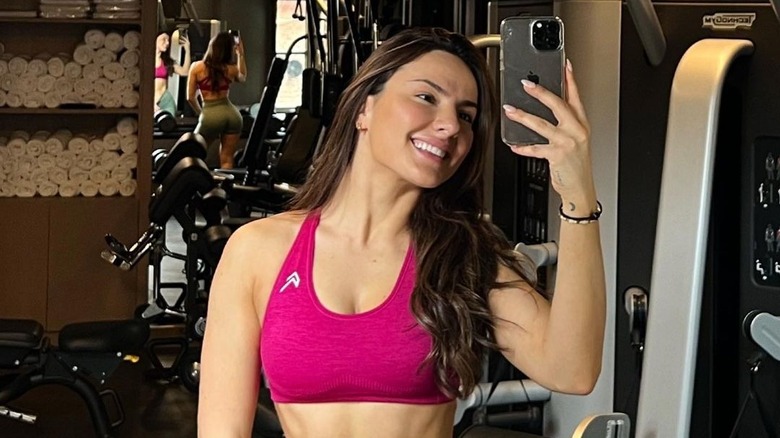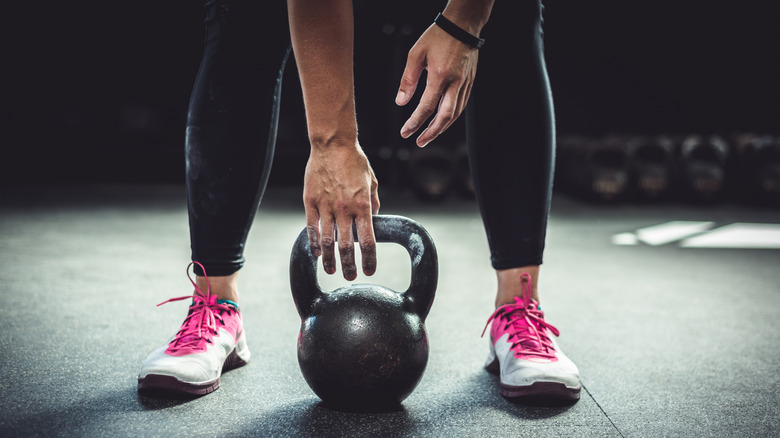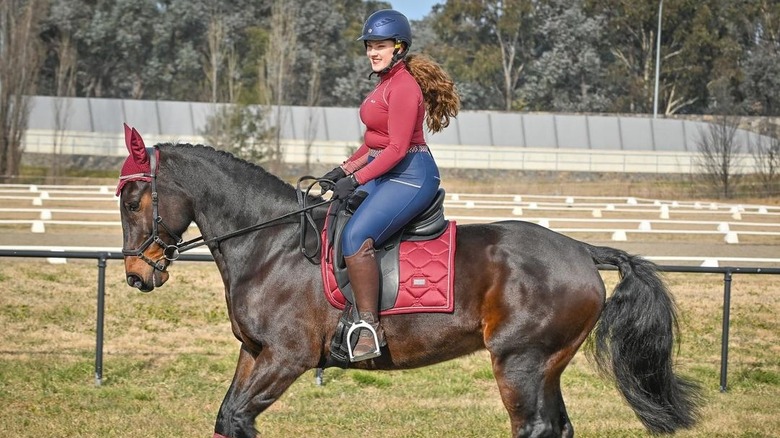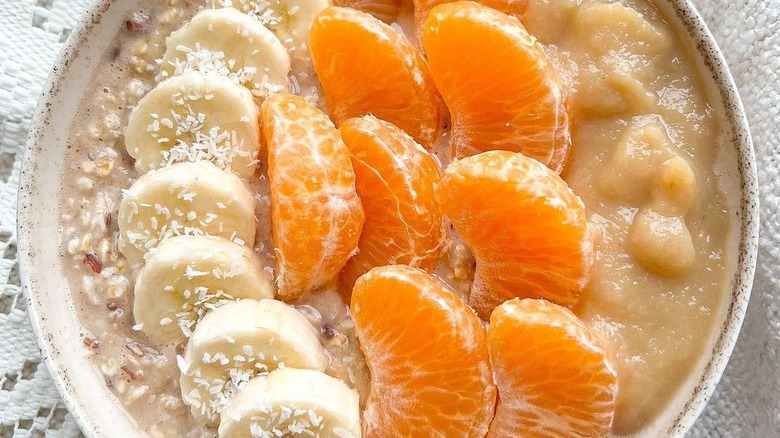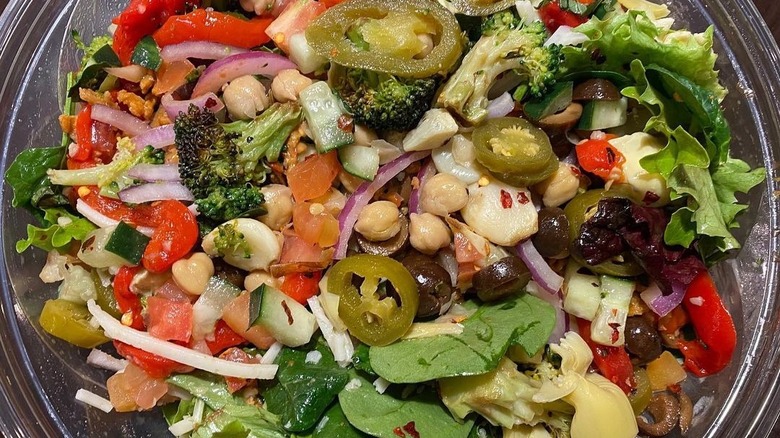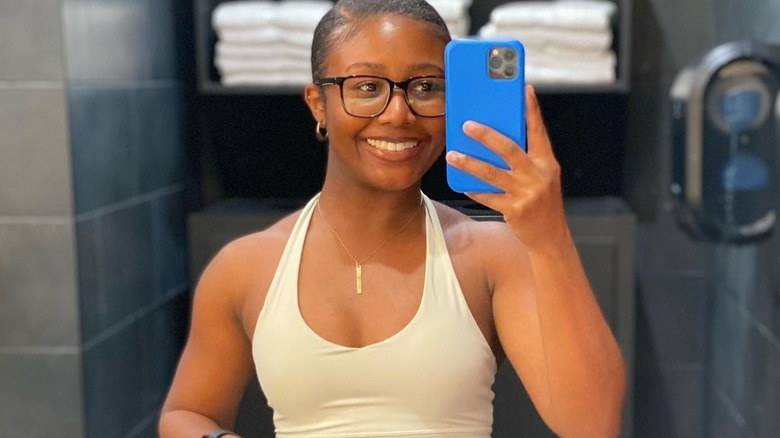15 Tips To Keep Your Fitness Goals On Track For 2023
Whether you work out at home or at the gym, it's important to be consistent with your training routine. You can't expect to get leaner, build mass, or get healthier in a week or two. These things take time and require a shift in mindset. Nearly 75% of those who set fitness goals for the New Year give up on them within weeks or months, according to Bodybuilding. Some find it challenging to follow a diet or workout plan, whereas others say they're too busy to hit the gym regularly.
The truth is, if you want something badly enough, you'll find a way to make it happen. Let's say you're on a tight schedule and barely have time for yourself. In this case, you could exercise at home or break your workouts into smaller chunks. Celebrity trainer Mike Donavanik recommends working out for half an hour in the morning and then for another 30 minutes later in the day. "For those 60-90 minutes when you're going all out, it can be both physically and mentally draining," he told Men's Health.
Getting started is often the hardest part, especially for those with a busy lifestyle or stressful jobs. With that in mind, here are 15 tips to keep your New Year's fitness goals on track.
Ditch the all-or-nothing mindset
Social media is flooded with images of people who work out every single day, prep their meals, and eat clean year round. But, while it's important to exercise regularly, you shouldn't beat yourself up for missing a training session. "I slowly realized that my workouts should work around me, my lifestyle, and my happiness, not the other way around," said fitness influencer Krissy Cela in an interview with Cosmopolitan.
There are no hard rules as to how often you should hit the gym or go for a run. Consider setting a minimum number of weekly workouts and take it from there. What matters most is to find your own rhythm and plan things around it.
Complete short, high-intensity workouts on your busiest days
Short, intense workouts can be just as effective as steady-state cardio, according to clinical research published in the Journal of Sports Science and Medicine. Good examples are Tabata or high-intensity interval training (HIIT), which take just a few minutes to complete. What you need to do is alternate between short, intense bursts of exercise and low-intensity recovery periods.
For example, you can run on the treadmill for 30 seconds, slow down for 30 seconds, run for another 30 seconds, and so on. Do it for 10 to 15 minutes at a time. This approach is ideal for those days when you have a tight schedule but still want to get your heart pumping.
Don't get stuck in a rut
Doing the same thing repetitively can suck the joy out of your day. This applies to exercise, too. If you repeat the same workouts week after week, you'll eventually lose motivation and get bored. What's more, you could end up overusing one or more muscle groups, which may lead to injuries.
"Diversifying your workout is all about exploring new ways to move your body. This could include any of the following; how fast or slow you are moving, if you are using props or not, trying a new modification, trying a new posture or even trying something completely new," explains Lisa Schale-Drake, director of research and development at Barre3.
Find a workout buddy
Working out with someone else is beneficial for both of you. A gym buddy can assist you with more challenging exercises, keep you accountable, and give you a push when you don't feel like training. Plus, your workouts will be a lot more fun.
Ideally, ask a friend or colleague to join you at the gym. If that's not an option, look for someone in local Facebook groups or use an app like Gym Buddy. Your best bet is to choose a person with the same schedule and fitness goals as you.
Set mini goals for each workout
Big goals, like shedding 20 pounds, take months to accomplish, and you might lose your motivation before you reach them. One solution is to set mini goals for each workout so you can keep your mojo up. Challenge yourself to lift an extra five pounds, run an extra mile, or try a new exercise.
If, say, you're not in the mood for exercise, aim for something small, such as 50 squats or three sets of crunches. Once you get the ball rolling, you may end up doing more than you planned.
Reward yourself for staying on track
Sometimes we all need an extra push to hit the gym. After all, no one is immune to stress and other challenges that come our way. If that's the case, try to reward yourself for staying on track with your fitness plans. For example, you could put aside $5 after every workout and buy something nice once you've saved $50.
There are lots of healthy ways to "bribe" yourself to go to the gym, such as taking a day trip or simply watching a movie. You could even schedule a photo shoot for when you reach your fitness goals.
Take before and after photos
Whether we're talking about weight loss or muscle growth, it's not always easy to see the progress we've made. Some changes are subtle, and we often look at ourselves with a critical eye.
Before-and-after photos may serve as a motivational tool, notes psychotherapist Eliza Kingsford. "There are times when the scale may not indicate how much progress has genuinely been made. These photos can be fantastic for offering visual evidence of progress," she said in an interview with MyFitnessPal. Kingsford recommends taking progress pictures at regular intervals rather than waiting for the "after" moment.
Make it personal
Not everyone enjoys lifting weights, running, or jogging, and that's okay. What matters most is choosing an activity you can stick to. If you're not a fan of cardio or strength training, you'll always find excuses to skip your workouts.
Traditional gym workouts are not your only option. Pilates, yoga, team sports, hiking, swimming, and horseback riding count as exercise, too. You could also take dance lessons, try indoor climbing, or ride your bike. The whole point is to pick an activity that fits your lifestyle and preferences.
Listen to your body
Working out harder won't necessarily bring you closer to your fitness goals. On the contrary, it could lead to fatigue, overtraining, and injuries. "Training is supposed to push you, but it's not supposed to break you," said personal trainer Ackeem Emmons in an interview with Insider.
While some soreness is normal after an intense workout, you shouldn't be in pain or have no energy. Listen to your body and give it a break as needed. Wait at least 48 hours before training the same muscle group again, and aim for two to four workouts per week, according to Bodybuilding.
Seek healthy alternatives to sugar
Nutrition and training are equally important. You can't expect to reach your fitness goals if your diet is based on junk food and sugary treats. However, this doesn't mean you have to change everything at once.
Start by cutting back on sugar and simple carbs, such as potato chips and white bread. Try not to exceed 6 teaspoons of added sugar per day if you're a woman, or 9 teaspoons per day if you're a man, recommends the American Heart Association. Swap out sugar with stevia, fresh fruit, unsweetened applesauce, cinnamon, or pureed bananas.
Boost your protein intake
If you've ever stepped foot in a gym, there's a good chance you've seen men and women sipping on protein shakes. Dietary protein increases satiety and keeps your metabolism up while maintaining lean mass. Moreover, it can boost your energy expenditure, making it easier to lose those pesky pounds, reports a 2012 review published in the British Journal of Nutrition.
This nutrient also plays a key role in muscle growth and repair, allowing you to train harder and longer, according to Ace Fitness. You can also add protein to your diet with lean meat, fish, eggs, low-fat dairy, legumes, nuts, seeds, and other high-protein foods.
Watch out for hidden sugars
Did you know that over 70% of packaged foods contain added sugar? This includes many so-called healthy foods, such as protein bars, veggie chips, flavored oatmeal, or low-carb snacks, according to the University of California San Francisco. For example, banana chips are often coated with sugar for extra flavor. Some manufacturers also add sugar to low-fat snacks or gluten-free foods.
This ingredient is listed under different names on food labels, Virta Health reports. High-fructose corn syrup, caramel, agave nectar, fruit juice concentrate, dextrose, maltose, and molasses are just a few examples.
Fill up on high-volume foods
You might have noticed that regular exercise can give you the munchies. "When we exercise, our bodies are burning fuel. As a result, our appetite is increased as a way of our body ensuring that the fuel sources are replaced," dietitian Casuarina Forsyth told Aaptiv. Physical activity also causes acute inflammation, increasing the stress hormone cortisol levels. This chain reaction leads to increased hunger and cravings, says Shape.
One way to keep your appetite in check is to fill up on high-volume foods. Leafy greens, cruciferous veggies, apples, berries, cucumbers, and other foods high in water can increase satiety without adding extra calories to your meal. For example, shredded lettuce has a mere 5 calories per cup, according to MyFitnessPal, so you can eat as much as you want without ruining your diet.
Eat for your goals
Eating for muscle growth isn't the same as eating for weight loss or better health. Each of these goals requires a different approach to nutrition and training. If you're trying to build muscle, you'll have to take in more calories than you burn. To lose weight, cut back on calories and increase your protein intake.
Also, note that not all calories are created equal, says a Columbia University answer board. It's one thing to get 500 calories from tuna and brown rice, and another thing to get the same number of calories from ice cream or cookies. Whole or minimally processed foods, such as tuna and brown rice, are chock full of protein, vitamins, minerals, and other key nutrients. Ultra-processed foods, by comparison, have little or no nutritional value.
Don't compare yourself to others
Social media is flooded with fitness influencers, health bloggers, and other folks who spend hours in the gym and count every calorie. Some look pretty amazing and seem to know it all. However, they may not have the same goals as you, and, realistically speaking, it's their job to look good. Plus, many of the photos shared on social media are heavily edited, notes fitness model Erin Stern (via BetaTOR).
Trust yourself, stick to your plan, and the results will come. Most importantly, follow your own path and do whatever feels good to you. Not everyone wants to have six-pack abs or look like a runway model, and that's perfectly fine. Remind yourself why you started, celebrate the small wins, and be proud of what you're capable of accomplishing.

